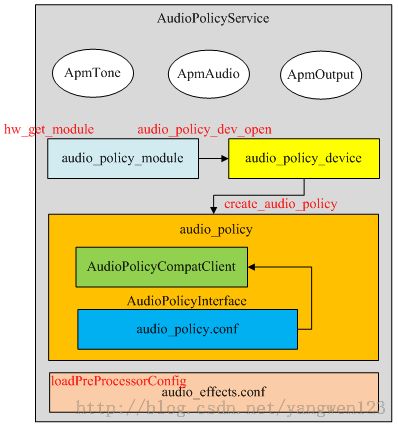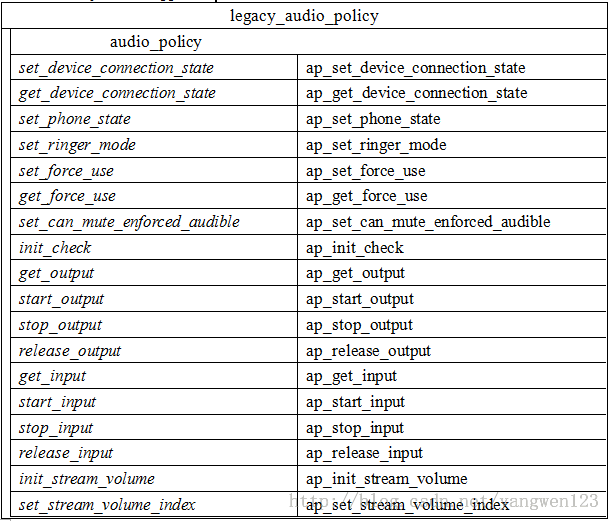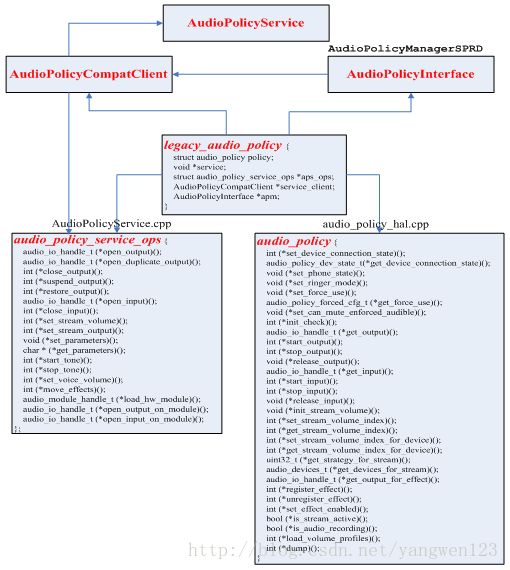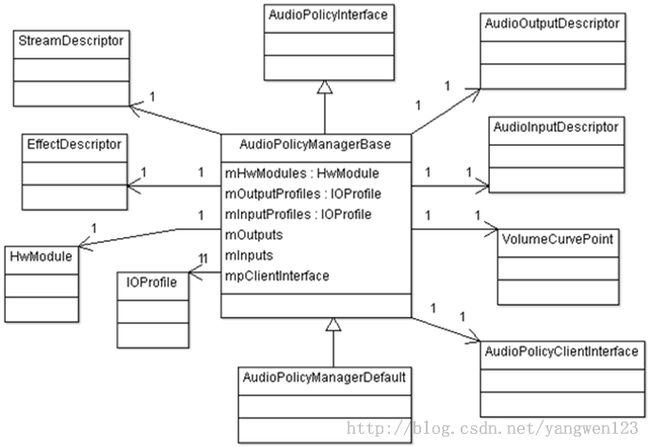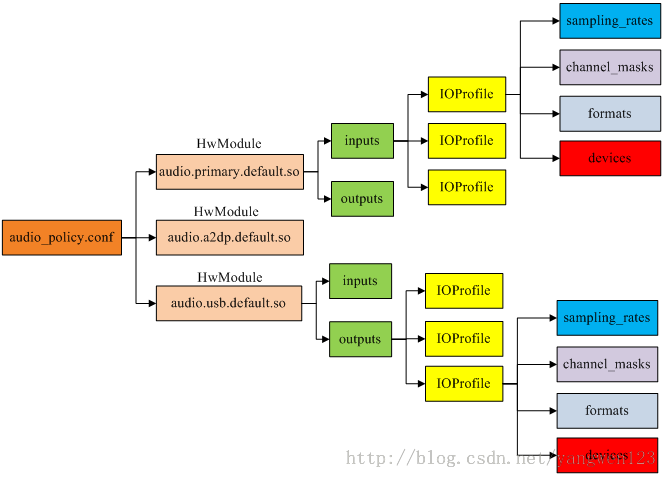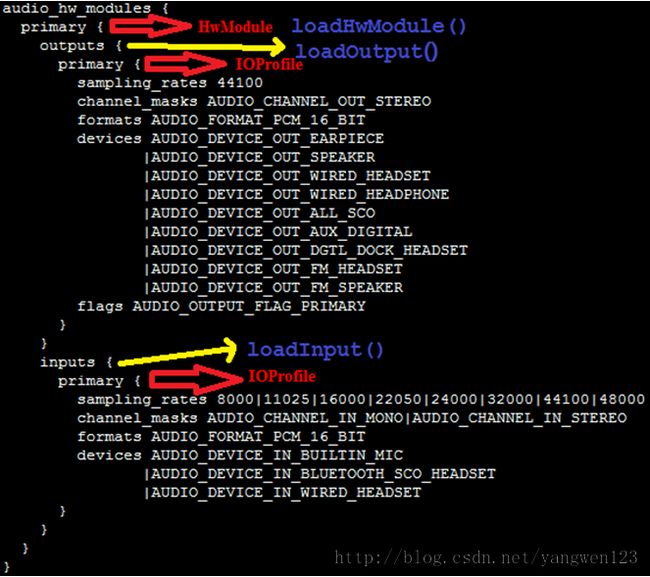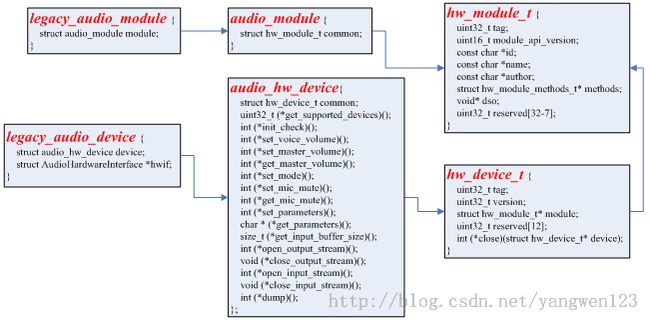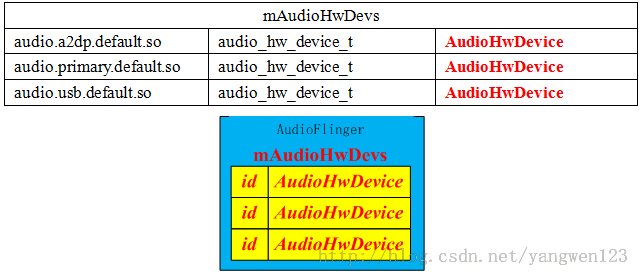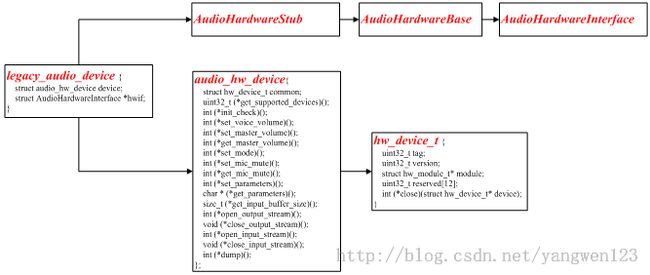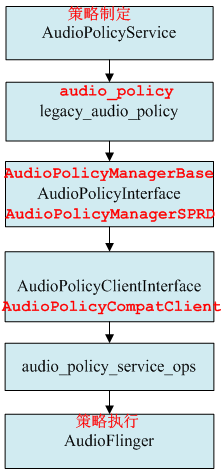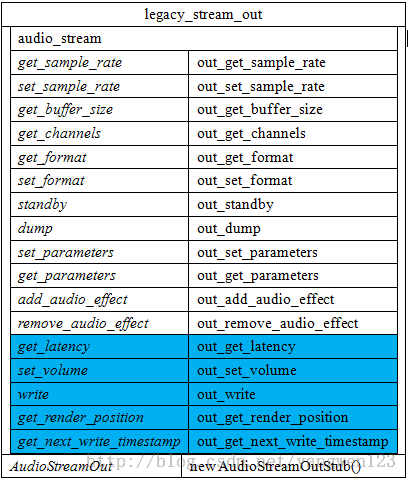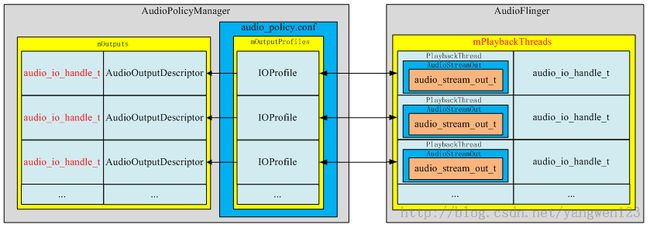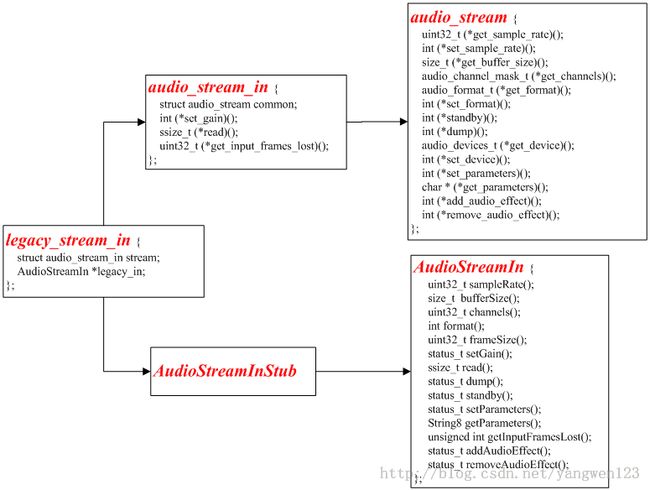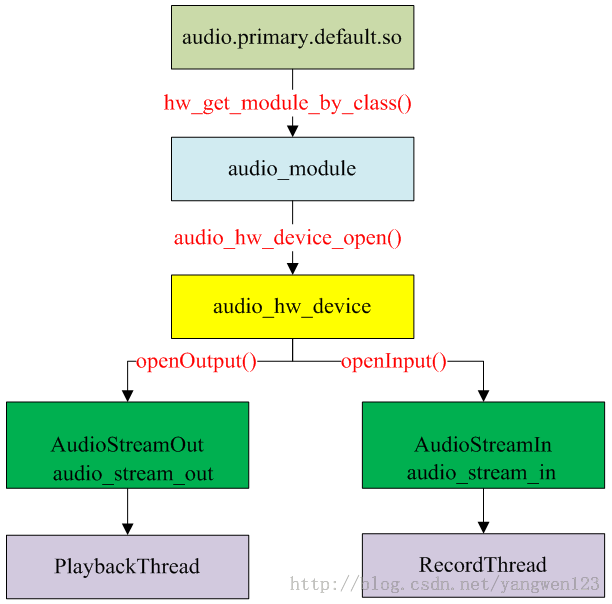深入剖析Android音频之AudioPolicyService
转自:http://blog.csdn.net/yangwen123/article/details/39497375#t4
AudioPolicyService是策略的制定者,比如什么时候打开音频接口设备、某种Stream类型的音频对应什么设备等等。而AudioFlinger则是策略的执行者,例如具体如何与音频设备通信,如何维护现有系统中的音频设备,以及多个音频流的混音如何处理等等都得由它来完成。AudioPolicyService根据用户配置来指导AudioFlinger加载设备接口,起到路由功能。
AudioPolicyService启动过程
AudioPolicyService服务运行在mediaserver进程中,随着mediaserver进程启动而启动。
frameworks\av\media\mediaserver\ Main_mediaserver.cpp
- int main(int argc, char** argv)
- {
- sp<ProcessState> proc(ProcessState::self());
- sp<IServiceManager> sm = defaultServiceManager();
- ALOGI("ServiceManager: %p", sm.get());
- VolumeManager::instantiate(); // volumemanager have to be started before audioflinger
- AudioFlinger::instantiate();
- MediaPlayerService::instantiate();
- CameraService::instantiate();
- AudioPolicyService::instantiate();
- ProcessState::self()->startThreadPool();
- IPCThreadState::self()->joinThreadPool();
- }
AudioPolicyService继承了模板类BinderService,该类用于注册native service。
frameworks\native\include\binder\ BinderService.h
- template<typename SERVICE>
- class BinderService
- {
- public:
- static status_t publish(bool allowIsolated = false) {
- sp<IServiceManager> sm(defaultServiceManager());
- return sm->addService(String16(SERVICE::getServiceName()), new SERVICE(), allowIsolated);
- }
- static void instantiate() { publish(); }
- };
BinderService是一个模板类,该类的publish函数就是完成向ServiceManager注册服务。
- static const char *getServiceName() { return "media.audio_policy"; }
AudioPolicyService注册名为media.audio_policy的服务。
- AudioPolicyService::AudioPolicyService()
- : BnAudioPolicyService() , mpAudioPolicyDev(NULL) , mpAudioPolicy(NULL)
- {
- char value[PROPERTY_VALUE_MAX];
- const struct hw_module_t *module;
- int forced_val;
- int rc;
- Mutex::Autolock _l(mLock);
- // start tone playback thread
- mTonePlaybackThread = new AudioCommandThread(String8("ApmTone"), this);
- // start audio commands thread
- mAudioCommandThread = new AudioCommandThread(String8("ApmAudio"), this);
- // start output activity command thread
- mOutputCommandThread = new AudioCommandThread(String8("ApmOutput"), this);
- /* instantiate the audio policy manager */
- /* 加载audio_policy.default.so库得到audio_policy_module模块 */
- rc = hw_get_module(AUDIO_POLICY_HARDWARE_MODULE_ID, &module);
- if (rc)
- return;
- /* 通过audio_policy_module模块打开audio_policy_device设备 */
- rc = audio_policy_dev_open(module, &mpAudioPolicyDev);
- ALOGE_IF(rc, "couldn't open audio policy device (%s)", strerror(-rc));
- if (rc)
- return;
- //通过audio_policy_device设备创建audio_policy
- rc = mpAudioPolicyDev->create_audio_policy(mpAudioPolicyDev, &aps_ops, this,
- &mpAudioPolicy);
- ALOGE_IF(rc, "couldn't create audio policy (%s)", strerror(-rc));
- if (rc)
- return;
- rc = mpAudioPolicy->init_check(mpAudioPolicy);
- ALOGE_IF(rc, "couldn't init_check the audio policy (%s)", strerror(-rc));
- if (rc)
- return;
- /* SPRD: maybe set this property better, but here just change the default value @{ */
- property_get("ro.camera.sound.forced", value, "1");
- forced_val = strtol(value, NULL, 0);
- ALOGV("setForceUse() !forced_val=%d ",!forced_val);
- mpAudioPolicy->set_can_mute_enforced_audible(mpAudioPolicy, !forced_val);
- ALOGI("Loaded audio policy from %s (%s)", module->name, module->id);
- // 读取audio_effects.conf文件
- if (access(AUDIO_EFFECT_VENDOR_CONFIG_FILE, R_OK) == 0) {
- loadPreProcessorConfig(AUDIO_EFFECT_VENDOR_CONFIG_FILE);
- } else if (access(AUDIO_EFFECT_DEFAULT_CONFIG_FILE, R_OK) == 0) {
- loadPreProcessorConfig(AUDIO_EFFECT_DEFAULT_CONFIG_FILE);
- }
- }
- 创建AudioCommandThread (ApmTone、ApmAudio、ApmOutput)
- 加载legacy_ap_module
- 打开legacy_ap_device
- 创建legacy_audio_policy
- 读取audio_effects.conf
创建AudioCommandThread线程
在AudioPolicyService对象构造过程中,分别创建了ApmTone、ApmAudio、ApmOutput三个AudioCommandThread线程:
1、 ApmTone用于播放tone音;
2、 ApmAudio用于执行audio命令;
3、ApmOutput用于执行输出命令;
在第一次强引用AudioCommandThread线程对象时,AudioCommandThread的onFirstRef函数被回调,在此启动线程
- void AudioPolicyService::AudioCommandThread::onFirstRef()
- {
- run(mName.string(), ANDROID_PRIORITY_AUDIO);
- }
这里采用异步方式来执行audio command,当需要执行上表中的命令时,首先将命令投递到AudioCommandThread的mAudioCommands命令向量表中,然后通过mWaitWorkCV.signal()唤醒AudioCommandThread线程,被唤醒的AudioCommandThread线程执行完command后,又通过mWaitWorkCV.waitRelative(mLock, waitTime)睡眠等待命令到来。
加载audio_policy_module模块
audio_policy硬件抽象层动态库位于/system/lib/hw/目录下,命名为:audio_policy.$(TARGET_BOARD_PLATFORM).so。audiopolicy的硬件抽象层定义在hardware\libhardware_legacy\audio\audio_policy_hal.cpp中,AUDIO_POLICY_HARDWARE_MODULE_ID硬件抽象模块定义如下:
hardware\libhardware_legacy\audio\ audio_policy_hal.cpp【audio_policy.scx15.so】
- struct legacy_ap_module HAL_MODULE_INFO_SYM = {
- module: {
- common: {
- tag: HARDWARE_MODULE_TAG,
- version_major: 1,
- version_minor: 0,
- id: AUDIO_POLICY_HARDWARE_MODULE_ID,
- name: "LEGACY Audio Policy HAL",
- author: "The Android Open Source Project",
- methods: &legacy_ap_module_methods,
- dso : NULL,
- reserved : {0},
- },
- },
- };
legacy_ap_module继承于audio_policy_module。
关于hw_get_module函数加载硬件抽象层模块的过程请参考Android硬件抽象Hardware库加载过程源码分析。
打开audio_policy_device设备
hardware\libhardware\include\hardware\ audio_policy.h
- static inline int audio_policy_dev_open(const hw_module_t* module,
- struct audio_policy_device** device)
- {
- return module->methods->open(module, AUDIO_POLICY_INTERFACE,
- (hw_device_t**)device);
- }
通过legacy_ap_module模块的open方法来打开一个legacy_ap_device设备。
hardware\libhardware_legacy\audio\ audio_policy_hal.cpp
- static int legacy_ap_dev_open(const hw_module_t* module, const char* name,
- hw_device_t** device)
- {
- struct legacy_ap_device *dev;
- if (strcmp(name, AUDIO_POLICY_INTERFACE) != 0)
- return -EINVAL;
- dev = (struct legacy_ap_device *)calloc(1, sizeof(*dev));
- if (!dev)
- return -ENOMEM;
- dev->device.common.tag = HARDWARE_DEVICE_TAG;
- dev->device.common.version = 0;
- dev->device.common.module = const_cast<hw_module_t*>(module);
- dev->device.common.close = legacy_ap_dev_close;
- dev->device.create_audio_policy = create_legacy_ap;
- dev->device.destroy_audio_policy = destroy_legacy_ap;
- *device = &dev->device.common;
- return 0;
- }
打开得到一个legacy_ap_device设备,通过该抽象设备可以创建一个audio_policy对象。
创建audio_policy对象
在打开legacy_ap_device设备时,该设备的create_audio_policy成员初始化为create_legacy_ap函数指针,我们通过legacy_ap_device设备可以创建一个legacy_audio_policy对象。
- rc = mpAudioPolicyDev->create_audio_policy(mpAudioPolicyDev, &aps_ops, this,
- &mpAudioPolicy);
这里通过audio_policy_device设备创建audio策略对象
hardware\libhardware_legacy\audio\ audio_policy_hal.cpp
- static int create_legacy_ap(const struct audio_policy_device *device,
- struct audio_policy_service_ops *aps_ops,
- void *service,
- struct audio_policy **ap)
- {
- struct legacy_audio_policy *lap;
- int ret;
- if (!service || !aps_ops)
- return -EINVAL;
- lap = (struct legacy_audio_policy *)calloc(1, sizeof(*lap));
- if (!lap)
- return -ENOMEM;
- lap->policy.set_device_connection_state = ap_set_device_connection_state;
- …
- lap->policy.dump = ap_dump;
- lap->policy.is_offload_supported = ap_is_offload_supported;
- lap->service = service;
- lap->aps_ops = aps_ops;
- lap->service_client = new AudioPolicyCompatClient(aps_ops, service);
- if (!lap->service_client) {
- ret = -ENOMEM;
- goto err_new_compat_client;
- }
- lap->apm = createAudioPolicyManager(lap->service_client);
- if (!lap->apm) {
- ret = -ENOMEM;
- goto err_create_apm;
- }
- *ap = &lap->policy;
- return 0;
- err_create_apm:
- delete lap->service_client;
- err_new_compat_client:
- free(lap);
- *ap = NULL;
- return ret;
- }
audio_policy实现在audio_policy_hal.cpp中,audio_policy_service_ops实现在AudioPolicyService.cpp中。create_audio_policy()函数就是创建并初始化一个legacy_audio_policy对象。
audio_policy与AudioPolicyService、AudioPolicyCompatClient之间的关系如下:
AudioPolicyClient创建
hardware\libhardware_legacy\audio\ AudioPolicyCompatClient.h
- AudioPolicyCompatClient(struct audio_policy_service_ops *serviceOps,void *service) :
- mServiceOps(serviceOps) , mService(service) {}
AudioPolicyCompatClient是对audio_policy_service_ops的封装类,对外提供audio_policy_service_ops数据结构中定义的接口。
AudioPolicyManager创建
- extern "C" AudioPolicyInterface* createAudioPolicyManager(AudioPolicyClientInterface *clientInterface)
- {
- ALOGI("SPRD policy manager created.");
- return new AudioPolicyManagerSPRD(clientInterface);
- }
使用AudioPolicyClientInterface对象来构造AudioPolicyManagerSPRD对象,AudioPolicyManagerSPRD继承于AudioPolicyManagerBase,而AudioPolicyManagerBase又继承于AudioPolicyInterface。
hardware\libhardware_legacy\audio\ AudioPolicyManagerBase.cpp
- AudioPolicyManagerBase::AudioPolicyManagerBase(AudioPolicyClientInterface *clientInterface)
- :
- #ifdef AUDIO_POLICY_TEST
- Thread(false),
- #endif //AUDIO_POLICY_TEST
- //变量初始化
- mPrimaryOutput((audio_io_handle_t)0),
- mAvailableOutputDevices(AUDIO_DEVICE_NONE),
- mPhoneState(AudioSystem::MODE_NORMAL),
- mLimitRingtoneVolume(false), mLastVoiceVolume(-1.0f),
- mTotalEffectsCpuLoad(0), mTotalEffectsMemory(0),
- mA2dpSuspended(false), mHasA2dp(false), mHasUsb(false), mHasRemoteSubmix(false),
- mSpeakerDrcEnabled(false), mFmOffGoing(false)
- {
- //引用AudioPolicyCompatClient对象,这样音频管理器AudioPolicyManager就可以使用audio_policy_service_ops中的接口
- mpClientInterface = clientInterface;
- for (int i = 0; i < AudioSystem::NUM_FORCE_USE; i++) {
- mForceUse[i] = AudioSystem::FORCE_NONE;
- }
- mA2dpDeviceAddress = String8("");
- mScoDeviceAddress = String8("");
- mUsbCardAndDevice = String8("");
- /**
- * 优先加载/vendor/etc/audio_policy.conf配置文件,如果该配置文件不存在,则
- * 加载/system/etc/audio_policy.conf配置文件,如果该文件还是不存在,则通过
- * 函数defaultAudioPolicyConfig()来设置默认音频接口
- */
- if (loadAudioPolicyConfig(AUDIO_POLICY_VENDOR_CONFIG_FILE) != NO_ERROR) {
- if (loadAudioPolicyConfig(AUDIO_POLICY_CONFIG_FILE) != NO_ERROR) {
- ALOGE("could not load audio policy configuration file, setting defaults");
- defaultAudioPolicyConfig();
- }
- }
- //设置各种音频流对应的音量调节点,must be done after reading the policy
- initializeVolumeCurves();
- // open all output streams needed to access attached devices
- for (size_t i = 0; i < mHwModules.size(); i++) {
- //通过名称打开对应的音频接口硬件抽象库
- mHwModules[i]->mHandle = mpClientInterface->loadHwModule(mHwModules[i]->mName);
- if (mHwModules[i]->mHandle == 0) {
- ALOGW("could not open HW module %s", mHwModules[i]->mName);
- continue;
- }
- // open all output streams needed to access attached devices
- // except for direct output streams that are only opened when they are actually
- // required by an app.
- for (size_t j = 0; j < mHwModules[i]->mOutputProfiles.size(); j++)
- {
- const IOProfile *outProfile = mHwModules[i]->mOutputProfiles[j];
- //打开mAttachedOutputDevices对应的输出
- if ((outProfile->mSupportedDevices & mAttachedOutputDevices) &&
- ((outProfile->mFlags & AUDIO_OUTPUT_FLAG_DIRECT) == 0)) {
- //将输出IOProfile封装为AudioOutputDescriptor对象
- AudioOutputDescriptor *outputDesc = new AudioOutputDescriptor(outProfile);
- //设置当前音频接口的默认输出设备
- outputDesc->mDevice = (audio_devices_t)(mDefaultOutputDevice & outProfile->mSupportedDevices);
- //打开输出,在AudioFlinger中创建PlaybackThread线程,并返回该线程的id
- audio_io_handle_t output = mpClientInterface->openOutput(
- outProfile->mModule->mHandle,
- &outputDesc->mDevice,
- &outputDesc->mSamplingRate,
- &outputDesc->mFormat,
- &outputDesc->mChannelMask,
- &outputDesc->mLatency,
- outputDesc->mFlags);
- if (output == 0) {
- delete outputDesc;
- } else {
- //设置可以使用的输出设备为mAttachedOutputDevices
- mAvailableOutputDevices =(audio_devices_t)(mAvailableOutputDevices | (outProfile->mSupportedDevices & mAttachedOutputDevices));
- if (mPrimaryOutput == 0 && outProfile->mFlags & AUDIO_OUTPUT_FLAG_PRIMARY) {
- mPrimaryOutput = output;
- }
- //将输出描述符对象AudioOutputDescriptor及创建的PlaybackThread线程id以键值对形式保存
- addOutput(output, outputDesc);
- //设置默认输出设备
- setOutputDevice(output,(audio_devices_t)(mDefaultOutputDevice & outProfile->mSupportedDevices),true);
- }
- }
- }
- }
- ALOGE_IF((mAttachedOutputDevices & ~mAvailableOutputDevices),
- "Not output found for attached devices %08x",
- (mAttachedOutputDevices & ~mAvailableOutputDevices));
- ALOGE_IF((mPrimaryOutput == 0), "Failed to open primary output");
- updateDevicesAndOutputs();
- // add for bug158794 start
- char bootvalue[PROPERTY_VALUE_MAX];
- // prop sys.boot_completed will set 1 when system ready (ActivityManagerService.java)...
- property_get("sys.boot_completed", bootvalue, "");
- if (strncmp("1", bootvalue, 1) != 0) {
- startReadingThread();
- }
- // add for bug158794 end
- #ifdef AUDIO_POLICY_TEST
- ...
- #endif //AUDIO_POLICY_TEST
- }
AudioPolicyManagerBase对象构造过程中主要完成以下几个步骤:
1、 loadAudioPolicyConfig(AUDIO_POLICY_CONFIG_FILE)加载audio_policy.conf配置文件;
2、 initializeVolumeCurves()初始化各种音频流对应的音量调节点;
3、 加载audio policy硬件抽象库:mpClientInterface->loadHwModule(mHwModules[i]->mName)
4、 打开attached_output_devices输出:
mpClientInterface->openOutput();
5、 保存输出设备描述符对象:addOutput(output, outputDesc);
读取audio_policy.conf文件
Android为每种音频接口定义了对应的硬件抽象层,且编译为单独的so库。
每种音频接口定义了不同的输入输出,一个接口可以具有多个输入或者输出,每个输入输出有可以支持不同的音频设备。通过读取audio_policy.conf文件可以获取系统支持的音频接口参数。
audio_policy.conf文件定义了两种音频配置信息:
1、 当前系统支持的音频输入输出设备及默认输入输出设备;
这些信息时通过global_configuration配置项来设置,在global_configuration中定义了三种音频设备信息:
attached_output_devices:已连接的输出设备;
default_output_device:默认输出设备;
attached_input_devices:已连接的输入设备;
1、 系统支持的音频接口信息;
audio_policy.conf定义了系统支持的所有音频接口参数信息,比如primary、a2dp、usb等,对于primary定义如下:
a2dp定义:
usb定义:
每种音频接口包含输入输出,每种输入输出又包含多种输入输出配置,每种输入输出配置又支持多种音频设备。AudioPolicyManagerBase首先加载/vendor/etc/audio_policy.conf,如果该文件不存在,则加/system/etc/audio_policy.conf。
- status_t AudioPolicyManagerBase::loadAudioPolicyConfig(const char *path)
- {
- cnode *root;
- char *data;
- data = (char *)load_file(path, NULL);
- if (data == NULL) {
- return -ENODEV;
- }
- root = config_node("", "");
- //读取配置文件
- config_load(root, data);
- //解析global_configuration
- loadGlobalConfig(root);
- //解析audio_hw_modules
- loadHwModules(root);
- config_free(root);
- free(root);
- free(data);
- ALOGI("loadAudioPolicyConfig() loaded %s\n", path);
- return NO_ERROR;
- }
通过loadGlobalConfig(root)函数来读取这些全局配置信息。
- void AudioPolicyManagerBase::loadGlobalConfig(cnode *root)
- {
- cnode *node = config_find(root, GLOBAL_CONFIG_TAG);
- if (node == NULL) {
- return;
- }
- node = node->first_child;
- while (node) {
- //attached_output_devices AUDIO_DEVICE_OUT_EARPIECE
- if (strcmp(ATTACHED_OUTPUT_DEVICES_TAG, node->name) == 0) {
- mAttachedOutputDevices = parseDeviceNames((char *)node->value);
- ALOGW_IF(mAttachedOutputDevices == AUDIO_DEVICE_NONE,
- "loadGlobalConfig() no attached output devices");
- ALOGV("loadGlobalConfig()mAttachedOutputDevices%04x", mAttachedOutputDevices);
- //default_output_device AUDIO_DEVICE_OUT_SPEAKER
- } else if (strcmp(DEFAULT_OUTPUT_DEVICE_TAG, node->name) == 0) {
- mDefaultOutputDevice= (audio_devices_t)stringToEnum(sDeviceNameToEnumTable,ARRAY_SIZE(sDeviceNameToEnumTable),(char *)node->value);
- ALOGW_IF(mDefaultOutputDevice == AUDIO_DEVICE_NONE,
- "loadGlobalConfig() default device not specified");
- ALOGV("loadGlobalConfig() mDefaultOutputDevice %04x", mDefaultOutputDevice);
- //attached_input_devices AUDIO_DEVICE_IN_BUILTIN_MIC
- } else if (strcmp(ATTACHED_INPUT_DEVICES_TAG, node->name) == 0) {
- mAvailableInputDevices = parseDeviceNames((char *)node->value) & ~AUDIO_DEVICE_BIT_IN;
- ALOGV("loadGlobalConfig() mAvailableInputDevices %04x", mAvailableInputDevices);
- //speaker_drc_enabled
- } else if (strcmp(SPEAKER_DRC_ENABLED_TAG, node->name) == 0) {
- mSpeakerDrcEnabled = stringToBool((char *)node->value);
- ALOGV("loadGlobalConfig() mSpeakerDrcEnabled = %d", mSpeakerDrcEnabled);
- }
- node = node->next;
- }
- }
audio_policy.conf同时定义了多个audio 接口,每一个audio 接口包含若干output和input,而每个output和input又同时支持多种输入输出模式,每种输入输出模式又支持若干种设备。
通过loadHwModules ()函数来加载系统配置的所有audio 接口:
- void AudioPolicyManagerBase::loadHwModules(cnode *root)
- {
- //audio_hw_modules
- cnode *node = config_find(root, AUDIO_HW_MODULE_TAG);
- if (node == NULL) {
- return;
- }
- node = node->first_child;
- while (node) {
- ALOGV("loadHwModules() loading module %s", node->name);
- //加载音频接口
- loadHwModule(node);
- node = node->next;
- }
- }
由于audio_policy.conf可以定义多个音频接口,因此该函数循环调用loadHwModule()来解析每个音频接口参数信息。Android定义HwModule类来描述每一个audio 接口参数,定义IOProfile类来描述输入输出模式配置。
到此就将audio_policy.conf文件中音频接口配置信息解析到了AudioPolicyManagerBase的成员变量mHwModules、mAttachedOutputDevices、mDefaultOutputDevice、mAvailableInputDevices中。
初始化音量调节点
音量调节点设置在Android4.1与Android4.4中的实现完全不同,在Android4.1中是通过VolumeManager服务来管理,通过devicevolume.xml文件来配置,但Android4.4取消了VolumeManager服务,将音量控制放到AudioPolicyManagerBase中。在AudioPolicyManagerBase中定义了音量调节对应的音频流描述符数组:
- StreamDescriptor mStreams[AudioSystem::NUM_STREAM_TYPES];
initializeVolumeCurves()函数就是初始化该数组元素:
- void AudioPolicyManagerBase::initializeVolumeCurves()
- {
- for (int i = 0; i < AUDIO_STREAM_CNT; i++) {
- for (int j = 0; j < DEVICE_CATEGORY_CNT; j++) {
- mStreams[i].mVolumeCurve[j] =
- sVolumeProfiles[i][j];
- }
- }
- // Check availability of DRC on speaker path: if available, override some of the speaker curves
- if (mSpeakerDrcEnabled) {
- mStreams[AUDIO_STREAM_SYSTEM].mVolumeCurve[DEVICE_CATEGORY_SPEAKER] =
- sDefaultSystemVolumeCurveDrc;
- mStreams[AUDIO_STREAM_RING].mVolumeCurve[DEVICE_CATEGORY_SPEAKER] =
- sSpeakerSonificationVolumeCurveDrc;
- mStreams[AUDIO_STREAM_ALARM].mVolumeCurve[DEVICE_CATEGORY_SPEAKER] =
- sSpeakerSonificationVolumeCurveDrc;
- mStreams[AUDIO_STREAM_NOTIFICATION].mVolumeCurve[DEVICE_CATEGORY_SPEAKER] =sSpeakerSonificationVolumeCurveDrc;
- }
- }
sVolumeProfiles数组定义了不同音频设备下不同音频流对应的音量调节档位,定义如下:
数组元素为音量调节档位,每种模式下的音量调节都包含4个档位,定义如下:
加载audio_module模块
AudioPolicyManager通过读取audio_policy.conf配置文件,可以知道系统当前支持那些音频接口以及attached的输入输出设备、默认输出设备。接下来就需要加载这些音频接口的硬件抽象库。
这三中音频接口硬件抽象定义如下:
/vendor/sprd/open-source/libs/audio/audio_hw.c 【audio.primary.scx15.so】
- struct audio_module HAL_MODULE_INFO_SYM = {
- .common = {
- .tag = HARDWARE_MODULE_TAG,
- .module_api_version = AUDIO_MODULE_API_VERSION_0_1,
- .hal_api_version = HARDWARE_HAL_API_VERSION,
- .id = AUDIO_HARDWARE_MODULE_ID,
- .name = "Spreadtrum Audio HW HAL",
- .author = "The Android Open Source Project",
- .methods = &hal_module_methods,
- },
- };
external/bluetooth/bluedroid/audio_a2dp_hw/audio_a2dp_hw.c【audio.a2dp.default.so】
- struct audio_module HAL_MODULE_INFO_SYM = {
- .common = {
- .tag = HARDWARE_MODULE_TAG,
- .version_major = 1,
- .version_minor = 0,
- .id = AUDIO_HARDWARE_MODULE_ID,
- .name = "A2DP Audio HW HAL",
- .author = "The Android Open Source Project",
- .methods = &hal_module_methods,
- },
- };
hardware/libhardware/modules/usbaudio/audio_hw.c【audio. usb.default.so】
- struct audio_module HAL_MODULE_INFO_SYM = {
- .common = {
- .tag = HARDWARE_MODULE_TAG,
- .module_api_version = AUDIO_MODULE_API_VERSION_0_1,
- .hal_api_version = HARDWARE_HAL_API_VERSION,
- .id = AUDIO_HARDWARE_MODULE_ID,
- .name = "USB audio HW HAL",
- .author = "The Android Open Source Project",
- .methods = &hal_module_methods,
- },
- };
AudioPolicyClientInterface提供了加载音频接口硬件抽象库的接口函数,通过前面的介绍,我们知道,AudioPolicyCompatClient通过代理audio_policy_service_ops实现AudioPolicyClientInterface接口。
hardware\libhardware_legacy\audio\ AudioPolicyCompatClient.cpp
- audio_module_handle_t AudioPolicyCompatClient::loadHwModule(const char *moduleName)
- {
- return mServiceOps->load_hw_module(mService, moduleName);
- }
AudioPolicyCompatClient将音频模块加载工作交给audio_policy_service_ops
frameworks\av\services\audioflinger\ AudioPolicyService.cpp
- static audio_module_handle_t aps_load_hw_module(void *service,const char *name)
- {
- sp<IAudioFlinger> af = AudioSystem::get_audio_flinger();
- if (af == 0) {
- ALOGW("%s: could not get AudioFlinger", __func__);
- return 0;
- }
- return af->loadHwModule(name);
- }
AudioPolicyService又将其转交给AudioFlinger
frameworks\av\services\audioflinger\ AudioFlinger.cpp
- audio_module_handle_t AudioFlinger::loadHwModule(const char *name)
- {
- if (!settingsAllowed()) {
- return 0;
- }
- Mutex::Autolock _l(mLock);
- return loadHwModule_l(name);
- }
- audio_module_handle_t AudioFlinger::loadHwModule_l(const char *name)
- {
- for (size_t i = 0; i < mAudioHwDevs.size(); i++) {
- if (strncmp(mAudioHwDevs.valueAt(i)->moduleName(), name, strlen(name)) == 0) {
- ALOGW("loadHwModule() module %s already loaded", name);
- return mAudioHwDevs.keyAt(i);
- }
- }
- audio_hw_device_t *dev;
- //加载音频接口对应的so库,得到对应的音频接口设备audio_hw_device_t
- int rc = load_audio_interface(name, &dev);
- if (rc) {
- ALOGI("loadHwModule() error %d loading module %s ", rc, name);
- return 0;
- }
- mHardwareStatus = AUDIO_HW_INIT;
- rc = dev->init_check(dev);
- mHardwareStatus = AUDIO_HW_IDLE;
- if (rc) {
- ALOGI("loadHwModule() init check error %d for module %s ", rc, name);
- return 0;
- }
- if ((mMasterVolumeSupportLvl != MVS_NONE) &&
- (NULL != dev->set_master_volume)) {
- AutoMutex lock(mHardwareLock);
- mHardwareStatus = AUDIO_HW_SET_MASTER_VOLUME;
- dev->set_master_volume(dev, mMasterVolume);
- mHardwareStatus = AUDIO_HW_IDLE;
- }
- audio_module_handle_t handle = nextUniqueId();
- mAudioHwDevs.add(handle, new AudioHwDevice(name, dev));
- ALOGI("loadHwModule() Loaded %s audio interface from %s (%s) handle %d",
- name, dev->common.module->name, dev->common.module->id, handle);
- return handle;
- }
函数首先加载系统定义的音频接口对应的so库,并打开该音频接口的抽象硬件设备audio_hw_device_t,为每个音频接口设备生成独一无二的ID号,同时将打开的音频接口设备封装为AudioHwDevice对象,将系统中所有的音频接口设备保存到AudioFlinger的成员变量mAudioHwDevs中。
函数load_audio_interface根据音频接口名称来打开抽象的音频接口设备audio_hw_device_t。
- static int load_audio_interface(const char *if_name, audio_hw_device_t **dev)
- {
- const hw_module_t *mod;
- int rc;
- //根据名字加载audio_module模块
- rc = hw_get_module_by_class(AUDIO_HARDWARE_MODULE_ID, if_name, &mod);
- ALOGE_IF(rc, "%s couldn't load audio hw module %s.%s (%s)", __func__,
- AUDIO_HARDWARE_MODULE_ID, if_name, strerror(-rc));
- if (rc) {
- goto out;
- }
- //打开audio_device设备
- rc = audio_hw_device_open(mod, dev);
- ALOGE_IF(rc, "%s couldn't open audio hw device in %s.%s (%s)", __func__,
- AUDIO_HARDWARE_MODULE_ID, if_name, strerror(-rc));
- if (rc) {
- goto out;
- }
- if ((*dev)->common.version != AUDIO_DEVICE_API_VERSION_CURRENT) {
- ALOGE("%s wrong audio hw device version %04x", __func__, (*dev)->common.version);
- rc = BAD_VALUE;
- goto out;
- }
- return 0;
- out:
- *dev = NULL;
- return rc;
- }
hardware\libhardware\include\hardware\ Audio.h
- static inline int audio_hw_device_open(const struct hw_module_t* module,
- struct audio_hw_device** device)
- {
- return module->methods->open(module, AUDIO_HARDWARE_INTERFACE,
- (struct hw_device_t**)device);
- }
hardware\libhardware_legacy\audio\ audio_hw_hal.cpp
- static int legacy_adev_open(const hw_module_t* module, const char* name,
- hw_device_t** device)
- {
- struct legacy_audio_device *ladev;
- int ret;
- if (strcmp(name, AUDIO_HARDWARE_INTERFACE) != 0)
- return -EINVAL;
- ladev = (struct legacy_audio_device *)calloc(1, sizeof(*ladev));
- if (!ladev)
- return -ENOMEM;
- ladev->device.common.tag = HARDWARE_DEVICE_TAG;
- ladev->device.common.version = AUDIO_DEVICE_API_VERSION_1_0;
- ladev->device.common.module = const_cast<hw_module_t*>(module);
- ladev->device.common.close = legacy_adev_close;
- ladev->device.get_supported_devices = adev_get_supported_devices;
- …
- ladev->device.dump = adev_dump;
- ladev->hwif = createAudioHardware();
- if (!ladev->hwif) {
- ret = -EIO;
- goto err_create_audio_hw;
- }
- *device = &ladev->device.common;
- return 0;
- err_create_audio_hw:
- free(ladev);
- return ret;
- }
打开音频接口设备过程其实就是构造并初始化legacy_audio_device对象过程,legacy_audio_device数据结构关系如下:
legacy_adev_open函数就是创建并初始化一个legacy_audio_device对象:
到此就加载完系统定义的所有音频接口,并生成相应的数据对象,如下图所示:
打开音频输出
AudioPolicyService加载完所有音频接口后,就知道了系统支持的所有音频接口参数,可以为音频输出提供决策。
为了能正常播放音频数据,需要创建抽象的音频输出接口对象,打开音频输出过程如下:
- audio_io_handle_t AudioPolicyCompatClient::openOutput(audio_module_handle_t module,
- audio_devices_t *pDevices,
- uint32_t *pSamplingRate,
- audio_format_t *pFormat,
- audio_channel_mask_t *pChannelMask,
- uint32_t *pLatencyMs,
- audio_output_flags_t flags,
- const audio_offload_info_t *offloadInfo)
- {
- return mServiceOps->open_output_on_module(mService,module, pDevices, pSamplingRate,
- pFormat, pChannelMask, pLatencyMs,
- flags, offloadInfo);
- }
- static audio_io_handle_t aps_open_output_on_module(void *service,
- audio_module_handle_t module,
- audio_devices_t *pDevices,
- uint32_t *pSamplingRate,
- audio_format_t *pFormat,
- audio_channel_mask_t *pChannelMask,
- uint32_t *pLatencyMs,
- audio_output_flags_t flags,
- const audio_offload_info_t *offloadInfo)
- {
- sp<IAudioFlinger> af = AudioSystem::get_audio_flinger();
- if (af == 0) {
- ALOGW("%s: could not get AudioFlinger", __func__);
- return 0;
- }
- return af->openOutput(module, pDevices, pSamplingRate, pFormat, pChannelMask,
- pLatencyMs, flags, offloadInfo);
- }
- audio_io_handle_t AudioFlinger::openOutput(audio_module_handle_t module,
- audio_devices_t *pDevices,
- uint32_t *pSamplingRate,
- audio_format_t *pFormat,
- audio_channel_mask_t *pChannelMask,
- uint32_t *pLatencyMs,
- audio_output_flags_t flags,
- const audio_offload_info_t *offloadInfo)
- {
- PlaybackThread *thread = NULL;
- struct audio_config config;
- config.sample_rate = (pSamplingRate != NULL) ? *pSamplingRate : 0;
- config.channel_mask = (pChannelMask != NULL) ? *pChannelMask : 0;
- config.format = (pFormat != NULL) ? *pFormat : AUDIO_FORMAT_DEFAULT;
- if (offloadInfo) {
- config.offload_info = *offloadInfo;
- }
- //创建一个音频输出流对象audio_stream_out_t
- audio_stream_out_t *outStream = NULL;
- AudioHwDevice *outHwDev;
- ALOGV("openOutput(), module %d Device %x, SamplingRate %d, Format %#08x, Channels %x, flags %x",
- module,
- (pDevices != NULL) ? *pDevices : 0,
- config.sample_rate,
- config.format,
- config.channel_mask,
- flags);
- ALOGV("openOutput(), offloadInfo %p version 0x%04x",
- offloadInfo, offloadInfo == NULL ? -1 : offloadInfo->version );
- if (pDevices == NULL || *pDevices == 0) {
- return 0;
- }
- Mutex::Autolock _l(mLock);
- //从音频接口列表mAudioHwDevs中查找出对应的音频接口,如果找不到,则重新加载音频接口动态库
- outHwDev = findSuitableHwDev_l(module, *pDevices);
- if (outHwDev == NULL)
- return 0;
- //取出module对应的audio_hw_device_t设备
- audio_hw_device_t *hwDevHal = outHwDev->hwDevice();
- //为音频输出流生成一个独一无二的id号
- audio_io_handle_t id = nextUniqueId();
- mHardwareStatus = AUDIO_HW_OUTPUT_OPEN;
- //打开音频输出流
- status_t status = hwDevHal->open_output_stream(hwDevHal,
- id,
- *pDevices,
- (audio_output_flags_t)flags,
- &config,
- &outStream);
- mHardwareStatus = AUDIO_HW_IDLE;
- ALOGV("openOutput() openOutputStream returned output %p, SamplingRate %d, Format %#08x, "
- "Channels %x, status %d",
- outStream,
- config.sample_rate,
- config.format,
- config.channel_mask,
- status);
- if (status == NO_ERROR && outStream != NULL) {
- //使用AudioStreamOut来封装音频输出流audio_stream_out_t
- AudioStreamOut *output = new AudioStreamOut(outHwDev, outStream, flags);
- //根据flag标志位,创建不同类型的线程
- if (flags & AUDIO_OUTPUT_FLAG_COMPRESS_OFFLOAD) {
- thread = new OffloadThread(this, output, id, *pDevices);
- ALOGV("openOutput() created offload output: ID %d thread %p", id, thread);
- } else if ((flags & AUDIO_OUTPUT_FLAG_DIRECT) ||
- (config.format != AUDIO_FORMAT_PCM_16_BIT) ||
- (config.channel_mask != AUDIO_CHANNEL_OUT_STEREO)) {
- thread = new DirectOutputThread(this, output, id, *pDevices);
- ALOGV("openOutput() created direct output: ID %d thread %p", id, thread);
- } else {
- thread = new MixerThread(this, output, id, *pDevices);
- ALOGV("openOutput() created mixer output: ID %d thread %p", id, thread);
- }
- //将创建的线程及id以键值对的形式保存在mPlaybackThreads中
- mPlaybackThreads.add(id, thread);
- if (pSamplingRate != NULL) {
- *pSamplingRate = config.sample_rate;
- }
- if (pFormat != NULL) {
- *pFormat = config.format;
- }
- if (pChannelMask != NULL) {
- *pChannelMask = config.channel_mask;
- }
- if (pLatencyMs != NULL) {
- *pLatencyMs = thread->latency();
- }
- // notify client processes of the new output creation
- thread->audioConfigChanged_l(AudioSystem::OUTPUT_OPENED);
- // the first primary output opened designates the primary hw device
- if ((mPrimaryHardwareDev == NULL) && (flags & AUDIO_OUTPUT_FLAG_PRIMARY)) {
- ALOGI("Using module %d has the primary audio interface", module);
- mPrimaryHardwareDev = outHwDev;
- AutoMutex lock(mHardwareLock);
- mHardwareStatus = AUDIO_HW_SET_MODE;
- hwDevHal->set_mode(hwDevHal, mMode);
- mHardwareStatus = AUDIO_HW_IDLE;
- }
- return id;
- }
- return 0;
- }
打开音频输出流过程其实就是创建AudioStreamOut对象及PlaybackThread线程过程。首先通过抽象的音频接口设备audio_hw_device_t来创建输出流对象legacy_stream_out。
- static int adev_open_output_stream(struct audio_hw_device *dev,
- audio_io_handle_t handle,
- audio_devices_t devices,
- audio_output_flags_t flags,
- struct audio_config *config,
- struct audio_stream_out **stream_out)
- {
- struct legacy_audio_device *ladev = to_ladev(dev);
- status_t status;
- struct legacy_stream_out *out;
- int ret;
- //分配一个legacy_stream_out对象
- out = (struct legacy_stream_out *)calloc(1, sizeof(*out));
- if (!out)
- return -ENOMEM;
- devices = convert_audio_device(devices, HAL_API_REV_2_0, HAL_API_REV_1_0);
- //创建AudioStreamOut对象
- out->legacy_out = ladev->hwif->openOutputStream(devices, (int *) &config->format,
- &config->channel_mask,
- &config->sample_rate, &status);
- if (!out->legacy_out) {
- ret = status;
- goto err_open;
- }
- //初始化成员变量audio_stream
- out->stream.common.get_sample_rate = out_get_sample_rate;
- …
- *stream_out = &out->stream;
- return 0;
- err_open:
- free(out);
- *stream_out = NULL;
- return ret;
- }
由于legacy_audio_device的成员变量hwif的类型为AudioHardwareInterface,因此通过调用AudioHardwareInterface的接口openOutputStream()来创建AudioStreamOut对象。
- AudioStreamOut* AudioHardwareStub::openOutputStream(
- uint32_t devices, int *format, uint32_t *channels, uint32_t *sampleRate, status_t *status)
- {
- AudioStreamOutStub* out = new AudioStreamOutStub();
- status_t lStatus = out->set(format, channels, sampleRate);
- if (status) {
- *status = lStatus;
- }
- if (lStatus == NO_ERROR)
- return out;
- delete out;
- return 0;
- }
打开音频输出后,在AudioFlinger与AudioPolicyService中的表现形式如下:
打开音频输入
- audio_io_handle_t AudioPolicyCompatClient::openInput(audio_module_handle_t module,
- audio_devices_t *pDevices,
- uint32_t *pSamplingRate,
- audio_format_t *pFormat,
- audio_channel_mask_t *pChannelMask)
- {
- return mServiceOps->open_input_on_module(mService, module, pDevices,pSamplingRate, pFormat, pChannelMask);
- }
- static audio_io_handle_t aps_open_input_on_module(void *service,
- audio_module_handle_t module,
- audio_devices_t *pDevices,
- uint32_t *pSamplingRate,
- audio_format_t *pFormat,
- audio_channel_mask_t *pChannelMask)
- {
- sp<IAudioFlinger> af = AudioSystem::get_audio_flinger();
- if (af == 0) {
- ALOGW("%s: could not get AudioFlinger", __func__);
- return 0;
- }
- return af->openInput(module, pDevices, pSamplingRate, pFormat, pChannelMask);
- }
- audio_io_handle_t AudioFlinger::openInput(audio_module_handle_t module,
- audio_devices_t *pDevices,
- uint32_t *pSamplingRate,
- audio_format_t *pFormat,
- audio_channel_mask_t *pChannelMask)
- {
- status_t status;
- RecordThread *thread = NULL;
- struct audio_config config;
- config.sample_rate = (pSamplingRate != NULL) ? *pSamplingRate : 0;
- config.channel_mask = (pChannelMask != NULL) ? *pChannelMask : 0;
- config.format = (pFormat != NULL) ? *pFormat : AUDIO_FORMAT_DEFAULT;
- uint32_t reqSamplingRate = config.sample_rate;
- audio_format_t reqFormat = config.format;
- audio_channel_mask_t reqChannels = config.channel_mask;
- audio_stream_in_t *inStream = NULL;
- AudioHwDevice *inHwDev;
- if (pDevices == NULL || *pDevices == 0) {
- return 0;
- }
- Mutex::Autolock _l(mLock);
- inHwDev = findSuitableHwDev_l(module, *pDevices);
- if (inHwDev == NULL)
- return 0;
- audio_hw_device_t *inHwHal = inHwDev->hwDevice();
- audio_io_handle_t id = nextUniqueId();
- status = inHwHal->open_input_stream(inHwHal, id, *pDevices, &config,&inStream);
- ALOGV("openInput() openInputStream returned input %p, SamplingRate %d, Format %d, Channels %x, "
- "status %d",
- inStream,
- config.sample_rate,
- config.format,
- config.channel_mask,
- status);
- // If the input could not be opened with the requested parameters and we can handle the
- // conversion internally, try to open again with the proposed parameters. The AudioFlinger can
- // resample the input and do mono to stereo or stereo to mono conversions on 16 bit PCM inputs.
- if (status == BAD_VALUE &&reqFormat == config.format && config.format == AUDIO_FORMAT_PCM_16_BIT && (config.sample_rate <= 2 * reqSamplingRate) &&
- (popcount(config.channel_mask) <= FCC_2) && (popcount(reqChannels) <= FCC_2)) {
- ALOGV("openInput() reopening with proposed sampling rate and channel mask");
- inStream = NULL;
- status = inHwHal->open_input_stream(inHwHal, id, *pDevices, &config, &inStream);
- }
- if (status == NO_ERROR && inStream != NULL) {
- #ifdef TEE_SINK
- // Try to re-use most recently used Pipe to archive a copy of input for dumpsys,
- // or (re-)create if current Pipe is idle and does not match the new format
- ...
- #endif
- AudioStreamIn *input = new AudioStreamIn(inHwDev, inStream);
- // Start record thread
- // RecordThread requires both input and output device indication to forward to audio
- // pre processing modules
- thread = new RecordThread(this,
- input,
- reqSamplingRate,
- reqChannels,
- id,
- primaryOutputDevice_l(),
- *pDevices
- #ifdef TEE_SINK
- , teeSink
- #endif
- );
- mRecordThreads.add(id, thread);
- ALOGV("openInput() created record thread: ID %d thread %p", id, thread);
- if (pSamplingRate != NULL) {
- *pSamplingRate = reqSamplingRate;
- }
- if (pFormat != NULL) {
- *pFormat = config.format;
- }
- if (pChannelMask != NULL) {
- *pChannelMask = reqChannels;
- }
- // notify client processes of the new input creation
- thread->audioConfigChanged_l(AudioSystem::INPUT_OPENED);
- return id;
- }
- return 0;
- }
打开音频输入流过程其实就是创建AudioStreamIn对象及RecordThread线程过程。首先通过抽象的音频接口设备audio_hw_device_t来创建输出流对象legacy_stream_in。
- static int adev_open_input_stream(struct audio_hw_device *dev,
- audio_io_handle_t handle,
- audio_devices_t devices,
- struct audio_config *config,
- struct audio_stream_in **stream_in)
- {
- struct legacy_audio_device *ladev = to_ladev(dev);
- status_t status;
- struct legacy_stream_in *in;
- int ret;
- in = (struct legacy_stream_in *)calloc(1, sizeof(*in));
- if (!in)
- return -ENOMEM;
- devices = convert_audio_device(devices, HAL_API_REV_2_0, HAL_API_REV_1_0);
- in->legacy_in = ladev->hwif->openInputStream(devices, (int *) &config->format,
- &config->channel_mask,
- &config->sample_rate,
- &status, (AudioSystem::audio_in_acoustics)0);
- if (!in->legacy_in) {
- ret = status;
- goto err_open;
- }
- in->stream.common.get_sample_rate = in_get_sample_rate;
- …
- *stream_in = &in->stream;
- return 0;
- err_open:
- free(in);
- *stream_in = NULL;
- return ret;
- }
- AudioStreamIn* AudioHardwareStub::openInputStream(
- uint32_t devices, int *format, uint32_t *channels, uint32_t *sampleRate,
- status_t *status, AudioSystem::audio_in_acoustics acoustics)
- {
- // check for valid input source
- if (!AudioSystem::isInputDevice((AudioSystem::audio_devices)devices)) {
- return 0;
- }
- AudioStreamInStub* in = new AudioStreamInStub();
- status_t lStatus = in->set(format, channels, sampleRate, acoustics);
- if (status) {
- *status = lStatus;
- }
- if (lStatus == NO_ERROR)
- return in;
- delete in;
- return 0;
- }
打开音频输入创建了以下legacy_stream_in对象:
打开音频输入后,在AudioFlinger与AudioPolicyService中的表现形式如下:
当AudioPolicyManagerBase构造时,它会根据用户提供的audio_policy.conf来分析系统中有哪些audio接口(primary,a2dp以及usb),然后通过AudioFlinger::loadHwModule加载各audio接口对应的库文件,并依次打开其中的output(openOutput)和input(openInput):
->打开音频输出时创建一个audio_stream_out通道,并创建AudioStreamOut对象以及新建PlaybackThread播放线程。
-> 打开音频输入时创建一个audio_stream_in通道,并创建AudioStreamIn对象以及创建RecordThread录音线程。

